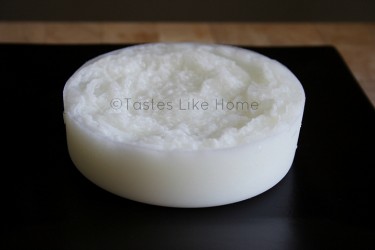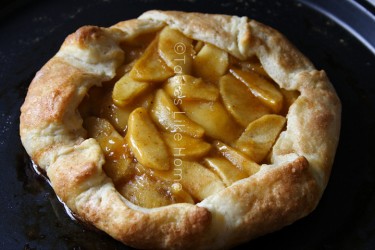Hi Everyone, I have never used coconut oil before, until now. And by golly I have been missing out. While I have always been intrigued by it, somehow I never got around to using coconut oil. The main thing I wanted to do was to test the refrigerated, hardened oil, to make pastry.
When I bought my coconut oil from a friend who makes it locally, I opened the container to have a look and was immediately greeted the most wonderful aroma. I could smell the coconut, clean and fresh, but there were other notes too – vanilla and sweet bay. Umm, sigh. I now understand why people use this as a moisturizer too.
Overnight, the oil was rock solid (due to the high amount of fatty acids). Studies have shown that the fatty acids found in coconut oil offer a variety of potential health benefits – aiding in digestion, regulation of cholesterol and blood pressure. It is no wonder that the cost of coconut oil is astronomical. I paid Bds$36 (US$16.50) for a 1¾ cup container of the liquid oil.
With my solid coconut oil, I set about making the pastry dough to use to make some apple turnovers. Here are my kitchen notes.
The solidified coconut oil was harder than cold butter. I actually cut one of my fingers deeply while pressing down on the knife to cut the hardened block. The knife slipped because it was difficult to cut smoothly.
- Due to the rock-solid nature of the hardened oil, it was difficult to cut into small pieces, as one would do with butter before cutting it into the flour so I ended up chopping it into large chunks and mixing the dough in a food processor. If I had done the cut-in by hand or using a pastry blender, it would have taken a longer time and the oil would have begun to melt. The general melting point for coconut oil is 76 degrees F and given that we live in a warm climate where the temperatures are warmer, the coconut oil melts quickly and easily.
- When mixing the dough, I had to use more water than usual and that was because while butter contains water, coconut oil does not; it is a pure fat.
Apple Crostata (Coconut oil pastry dough) (Photo by Cynthia Nelson) Once mixed, patted into disks and wrapped tightly, the dough was refrigerated. When I was ready to make the turnovers a few hours later, I noticed that the dough did not require that usual “defrost” time that butter pastry does, the dough was ready to be rolled directly from the refrigerator. It was not rock solid. Go figure. I liked that.
- Rolling out the dough was easy but once I started working with it – cutting, filling, brushing with egg wash and sealing – the dough became warm and soft rather quickly and I found myself having to work quicker than normal when using pastry. This meant that once the turnovers were prepped, they had to be refrigerated in order for the dough to firm up. I would suggest a 15 – 20 minutes chill time. I put it in the freezer and on the top shelf of the refrigerator and baked directly from the freezer and refrigerator in a preheated oven.
- Baked, the pastry puffs up well; it is light and flaky. The pastry dough is different from short crust pastry. It is like a cross between short crust, puff and flaky pastry dough. This combination texture and feel is due to the transformation of the liquid oil to solid and then to liquid again at a high temperature (while baking).
- The flavour of coconut is present in the pastry (obviously), but its aromatic presence adds another dimension of enjoyment when eating the pastry.
- Eaten warm or at room temperature it is best. The pastry freezes well. To reheat, bring it naturally to room temperature and then place in a low-heat oven to warm through. As a rule, microwaves ruin pastries when reheated that way.

I still have some of the solid coconut oil left back… you know right? What do you think I am going to make? Scones of course! Will let you know how they turn out.
If you would like to try using the hardened coconut oil to make pastry, simply switch out the butter by weight or volume whichever your pastry dough recipe indicates. In other words, if the dough needs 4 ounces of butter, replace it with 4 ounces of the hardened coconut oil.
Finally, while I would really like to keep using coconut oil for my pastries, I’ll only be doing so sparingly. The high cost of coconut oil compared to butter puts the coconut oil out of my everyday reach. Anyone in Guyana wants to send me some?
Cynthia







